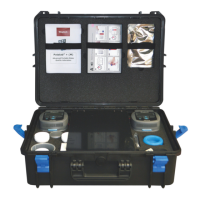7.1 Enumeration Procedure
Following incubation, remove the petri dishes
from
the incubator. Take note of the temperature
at which
the samples were incubated.
Remove the petri dishes from the rack and
place on the clean work-surface.
Remove the lids and, using the hand-lens if
necessary, count all yellow colonies.
• If the incubation temperature was 37ºC then
the yellow colonies represent a count for
Total Coliforms
• If the incubation temperature was 44ºC then
the yellow colonies represent a count for
Thermotolerant Coliforms
7.2 Disposal of Used Materials
Before disposal, any materials used in the
microbiological analysis must be made safe.
Potentially contaminated materials include
Absorbent Pads and Filter Membranes.
Used pads and membranes cannot simply be
thrown away after use as they represent a
significant potential risk to public health.
Components can be made safe by sterilising
the petri dishes and their contents. Ideally this
should be carried out using an autoclave at
121ºC for 15 minutes. Alternatively, a pressure
cooker may be used. Once sterilised, the
used pads and membranes can be incinerated.
The petri dishes should be washed and
re-sterilised, ready for the next use.
29
7
Microbiological Results
7.0 Microbiological Results
Bacteria in water are generally not present individually but as clumps or in association with
particulate matter.
When enumerating bacteria in water it is not the number of individual bacteria present which are
counted but the number of clumps of bacteria or the particles and their associated bacteria. Each
clump or particle may have many bacteria associated with it.
Membrane filtration and colony count techniques assume that each bacterium, clump of bacteria, or
particle with bacteria attached will give rise to a single visible colony. Each of these clumps or particles
is therefore a Colony Forming Unit (CFU) and the results are expressed as
colony forming units per
unit volume. For standard volumes of sample this would be CFU/100ml.
This may vary depending on the type of water being tested and the volume of sample water
actually filtered.
Useful to Know
• Count the colonies within a few minutes,
as the colours are liable to change on
cooling and standing
• Always try to have more than one
person counting
• Try to count in the best available
natural light - avoiding direct sunlight
• Count yellow colonies that are >1mm
diameter
• DO NOT count colonies that are CLEAR, RED
or ANY OTHER COLOUR - these bacteria
do not ferment lactose and are not
Thermotolerant Coliforms
• Gridded membrane filters permit easier
counting when large numbers of colonies
are visible
• Count colonies systematically, column
by column in the grid
• Where there are too many colonies to count
or it is difficult to see individual colonies
clearly, mark the result as “Too Numerous
To Count” (TNTC)

